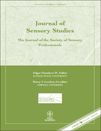DEVELOPMENT OF A SENSORY TEST METHOD FOR ODOR MEASUREMENT IN A PACKAGE HEADSPACE
Abstract
ABSTRACT
The aim of the present study was to develop a sensory method to evaluate off-odors in a package headspace relative to a reference scale. Selection of panelists was performed with a questionnaire and with the Sniffin' stick test. A 1-butanol reference scale and three types of scales (a 15-cm line, a color-graded brightness line scale and a color-graded brightness category scale) were compared. 1-butanol proved to be a reliable reference scale for the off-odor intensity in the package headspace. The type of scales did not affect the odor intensity ratings; however, the color-graded brightness line scale tended to give a greater accuracy of scored odor intensity. The color-graded brightness scale may strengthen the repeatability of the intensity measures due to the cross-modal support in the judgment processes. The method allows the conversion of intensity judgment of a package headspace to a physical intensity scale of 1-butanol and thus provides a valuable reference for comparing different package assessments over time.
PRACTICAL APPLICATIONS
A method for assessing off-odors in a package headspace is developed. The method development includes everything from selection and monitoring of the sensory panel to evaluation of different scaling techniques. Finally, a reliable and overtime fairly reproducible method for the evaluation of off-odors in the headspace of packages is presented.




